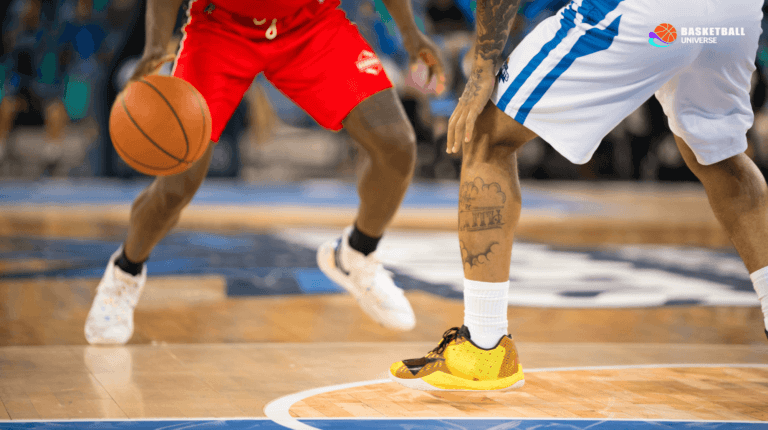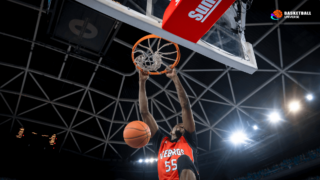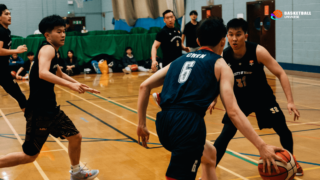
What Does Brick Mean in Basketball?
Written by: Basketball Universe
Last updated:

If you’ve ever tuned into a fast-paced basketball game, you might have heard the term “brick” being tossed around by passionate commentators or fired-up fans. If this word has left you puzzled, scratch your head no further! In this blog post, we’re going to break down the ins and outs of the term ‘brick’, its significance in basketball parlance, and how it impacts various aspects of the game. So, strap in, hoop-heads, because we’re about to dig deep into the world of basketball lingo and demystify the art of the “brick!
What Does Brick Mean in Basketball?
In basketball, a “brick” refers to a poorly executed shot that misses the target, often hitting the rim or backboard with a loud, clanking sound. It is generally used when a player fails to score due to a lack of accuracy, control, or finesse in their shooting technique. The term is commonly employed by commentators and fans alike to describe a particularly bad shot attempt.
An In-Depth Look at Bricking in Basketball
When it comes to understanding the ins and outs of basketball, a firm grasp of terminology is essential for anyone wanting to truly appreciate the game. The term “brick” refers to a bad shot, one that hits the rim or backboard with a loud, resounding noise. Let’s take a deep dive into the reasons behind a “brick” shot, how to avoid them, their impact on a game, and famous “brickers” in basketball history.
The Anatomy of a Brick Shot
A “brick” shot in basketball can occur for various reasons, but understanding its anatomy will enable you to spot these instances with ease. Here are some factors that contribute to a brick:
1. Poor Shooting Technique
One of the main reasons a shot turns into a brick is due to a player’s poor shooting technique. When a player fails to properly release the ball, apply enough backspin, or maintain their shooting form, they’re more prone to miss the target, often resulting in a brick.
2. Inadequate Arc
Another factor causing a brick is an inadequate arc on the shot. The ideal arc varies depending on a player’s height and shooting style, but generally, a higher arc improves the chances of the basketball falling through the hoop. A flat shot, with a low-trajectory, is more likely to hit the rim or backboard, resulting in that infamous brick.
3. Shooters Being Off-Balance
A player’s balance is crucial when executing a shot, as it influences the accuracy of their shooting. Even the most talented shooters can brick a shot if they are off-balance when attempting it, as this can throw off their whole form and technique.
4. A Rushed Shot or Shot Clock Pressure
Players sometimes have no choice but to shoot under pressure or within the shot clock’s dwindling seconds. Desperation shots—typically resulting from a lack of better options—are more likely to turn into bricks, as they often face increased resistance from the opponent’s defense.
Turning Bricks into Buckets: How to Improve Your Shooting Form
Improving shooting form is crucial to reducing the occurrence of bricks, ultimately enhancing one’s performance in basketball. Here are some tips to help you turn bricks into buckets:
1. Adopt a Consistent Stance and Shooting Form
Consistency is the key to a reliable shooting technique. Start with a solid base—feet shoulder-width apart and knees slightly bent—followed by proper alignment of the shooting arm and elbow. Consistency in shooting form increases the chances of accuracy and, consequently, minimizes the chances of bricking a shot.
2. Aim and Follow Through
When shooting, aim for a target: whether it’s the back of the rim or the center of the hoop. Focusing on the target can help improve shot accuracy. Furthermore, ensure a proper follow-through by keeping your arm extended and your fingers relaxed after releasing the basketball, which also helps in maintaining a consistent form.
3. Pay Attention to the Arc
As mentioned earlier, a higher arc generally increases the chances of making a shot. Practice achieving a consistent arc by visualizing a high, arcing trajectory on your shots. This may also help in reducing the risk of your shots being blocked by defenders.
4. Train Under Pressure
Become more accustomed to shooting under pressure by engaging in regular high-intensity training sessions. Incorporate simulated game conditions and practice contested shots. Doing so will bolster your confidence and make it less likely for you to flinch or falter when faced with a ticking shot clock or tight defense during an actual game.
Bricks that Break Records: Memorable Bricks in Basketball History
While bricks are largely seen as negative occurrences in basketball, some instances have left an indelible mark on the game’s history. Here are some famous bricks that won’t be fading from memory any time soon:
1. Finals Franchise Record: San Antonio Spurs (2013)
During Game 3 of the 2013 NBA Finals, the San Antonio Spurs set the record for the highest number of bricks during the first quarter. The team shot just 25% from the field, missing an astounding 18 shots, effectively creating a brickathon. However, the Spurs still managed to defeat the Miami Heat in that Finals series, establishing that it is possible to recover from a dismal shooting performance.
2. Nick Anderson’s Free Throw Debacle (1995)
Orlando Magic shooting guard Nick Anderson missed four crucial free throws in the closing seconds of Game 1 of the 1995 NBA Finals against the Houston Rockets. These bricks cost his team the game, which they ultimately lost in overtime. The Magic were eventually swept in the series, making Anderson’s bricks a significant part of NBA history.
Bricklayers: Notorious NBA Players Known for Poor Shooting
Even some of the greatest players in basketball history have found themselves acquiring a reputation as ‘bricklayers’ over time. Here are a few superstars who struggled with bricks during their illustrious NBA careers:
1. Shaquille O’Neal
Despite being an NBA legend, Hall of Famer, and multiple-time NBA champion, Shaquille O’Neal had a notoriously poor free-throw shooting record. Shaq’s career free-throw shooting percentage was a mere 52.7%, earning him the nickname “The Big Bricklayer”.
2. Ben Wallace
Former Detroit Pistons and Chicago Bulls player Ben Wallace was a force to be reckoned with on the defensive end. However, his offensive abilities, especially his free-throw shooting, left much to be desired. Wallace holds the dubious record of being the only player in NBA history to attempt over 1000 free throws with a shooting percentage below 45%.
3. Chuck Hayes
Chuck Hayes, who played for the Houston Rockets and Sacramento Kings, was another well-known bricklayer, with a career free-throw shooting percentage of 62%. Perhaps more memorable was his unorthodox shooting style, which featured a long pause and various jerking motions—further cementing his bricklayer status.
Conclusion: Brick is Just One Piece of the Basketball Puzzle
Bricks are an unfortunate reality in basketball, even for the most skilled players. While brick shots happen during each game, understanding the keys to improving technique and making educated adjustments can help reduce the number of bricks for both amateur and professional players alike. It’s essential to remember that basketball is a game of numerous elements, and while bricks may be frustrating to watch, they are just one piece of the overall puzzle that makes this captivating sport so enjoyable.
Psychological Impacts of Bricks and the Importance of Confidence
While the physical aspects of bricks are widely discussed, the psychological consequences often fly under the radar. A player’s mental state plays a crucial role in their performance, and bricking shots time and again can take a toll on a player’s confidence. Understanding the connection between bricks and psychology is crucial for both players and coaches seeking to maintain a positive playing mindset.
1. Loss of Confidence in Shot-Making
Stringing together a series of bricked shots can significantly affect a player’s confidence in their shooting abilities. They may become hesitant to take shots they would typically make, negatively impacting their overall performance and contribution to the team.
2. The Snowball Effect
The snowball effect functions when a player’s diminished confidence after a brick leads to a further decrease in their shot-making abilities. This vicious cycle can rapidly escalate, affecting not only their shooting, but also their overall gameplay—resulting in poor passing, rebounding, or defensive efforts, among other shortcomings.
3. Overcoming the Mental Hurdles
Successfully overcoming the mental hurdles brought on by bricks requires a combination of coaching encouragement, teammate support, and personal mental fortitude. Practicing mindfulness techniques, visualization, and positive affirmations can help a player regain their confidence and bounce back from a bout of bricks.
Bricks and the Significance of Shooting Percentages
While an individual brick might not seem like a major issue during a game, they can accumulate and thus impact a player’s overall shooting percentage—potentially affecting their reputation and value to their team. It’s best to put the concept of shooting percentages in the context of bricks and explore how these aspects interrelate.
1. Field Goal Percentage
The field goal percentage represents the percentage of shots made from the field by a player or a team during a game or season. A higher amount of bricks inevitably leads to a lower field goal percentage, which can negatively impact a player’s reputation as a reliable scorer.
2. Free Throw Percentage
Free throw percentage refers to the number of free throws successfully converted out of total attempted by a player or team. A player consistently bricking free throws can eventually cost their team valuable points, while simultaneously lowering their free throw shooting percentage.
3. Three-Point Shooting Percentage
It’s important for players, especially guards and forwards, to be both accurate and efficient from beyond the three-point line. Bricks from three-point range not only hurt a player’s shooting percentage, but they also account for failed opportunities to add valuable points to their team’s total score.
Bricks: A Valuable Learning Opportunity
While bricking shots in basketball is typically viewed as a negative occurrence, it’s essential to recognize that it can also present valuable learning opportunities for players to grow and develop their skills, transforming their weaknesses into strengths. Here are some benefits of learning from bricks:
1. Improved Self-Awareness
When a player encounters a string of bricks, it can reveal areas that need improvement in their shooting game. Self-examination and evaluation of technique, form, and shot selection are vital for their continued growth.
2. Practice and Perseverance
Embracing bricks as learning experiences encourages players to practice more diligently and persistently, ultimately improving their overall skill set.
3. Team Development
A player’s struggles with brick shots can facilitate a stronger sense of teamwork, as teammates come together to offer support, provide feedback, and share their knowledge to help the player overcome their shooting slump.
In summary, while bricks are generally seen as unfavorable occurrences, they also offer opportunities for players to learn, grow, and develop resilience—qualities crucial for success both on and off the basketball court.
Frequently Asked Questions (FAQ) on Bricks in Basketball
We’ve compiled a list of frequently asked questions to help further your understanding of bricks in basketball, providing quick and concise answers for your convenience. Expand your knowledge and become well-versed when engaging in discussions about this fascinating aspect of the game.
1. What is the origin of the term “brick” in basketball?
The term “brick” in basketball is believed to have originated from the 1940s, stemming from the idea that a shot that missed its target felt as though it weighed like a “brick” or resembled the rough landing and rebound of an actual brick.
2. Can bricking a shot be beneficial in any situation?
While bricking a shot is generally undesirable, it can occasionally work to a player’s advantage. One example would be the “Kobe Assist”—named after the late NBA legend Kobe Bryant—where a missed shot (brick) bounces back to the shooter or a teammate for a higher-percentage follow-up shot, increasing the chance of scoring.
3. How does the term “air ball” differ from a “brick”?
An “air ball” is a type of shot that entirely misses the basket, including the rim and the backboard. Unlike a “brick,” an “air ball” doesn’t produce a loud clanking noise as it doesn’t make contact with the rim or backboard.
4. How important is footwork in preventing bricks?
Footwork plays a crucial role in generating power, balance and consistency in shooting. Proper footwork minimizes the likelihood of bricks, as it helps establish a more stable base from which to execute a shot.
5. How does fatigue impact the chances of bricking a shot?
Fatigue can negatively impact a player’s shooting mechanics and decision-making, leading to a higher likelihood of bricks. Tired players may experience diminished accuracy, strength and overall performance, resulting in poorly-executed shots.
6. Is it possible to completely eliminate bricks from a player’s game?
Although improvements in technique, form, and shot selection can significantly reduce bricks, it’s nearly impossible to completely eliminate them from a player’s game. Even the greatest shooters will occasionally experience a brick, as various factors are at play during live game situations.
7. Can the size, material, or condition of a basketball affect the chances of a brick?
Yes, the size, material, and condition of a basketball can influence the chances of a brick. Balls that are too big, too small, too slippery, or over-inflated make it challenging for the player to maintain a consistent shooting grip, ultimately increasing the likelihood of bricks.
8. Do different basketball court surfaces affect the occurrence of bricks?
Different court surfaces can potentially influence the occurrence of bricks, as variations like indoor and outdoor courts, court temperature and humidity, as well as the type of material used for the rim and backboard, may alter the ball’s bounce and behavior during a shot attempt.
9. Are bricks more common in beginners or experienced players?
Bricks are typically more common in beginner players due to their limited experience and underdeveloped shooting mechanics. That said, even experienced players are not immune to bricks, albeit they generally occur less frequently.
10. Can bricks have a significant impact on a team’s overall offensive strategy?
Yes, a consistent pattern of bricks among players can prompt coaches to reevaluate their offensive strategy. They may opt to focus on driving to the basket, encouraging more passing and teamwork, or seeking higher-percentage shot opportunities to mitigate the impact of poor shooting performances.
11. How do players train to minimize bricks during off-season?
Players often work with personal trainers, attend specific shooting clinics or camps, and engage in shooting drills to refine their mechanics, footwork, form and shot selection during the off-season, ultimately aiming to minimize bricks and improve their overall shooting abilities.
12. Are there any famous coaches known for helping players overcome bricking issues?
Yes, coaches like the renowned shooting coach Chip Engelland have successfully helped numerous NBA players improve their shooting abilities and minimize bricks. Engelland has worked with notable players like Tony Parker, Kawhi Leonard, and Bruce Bowen, among others.
13. Can bricks impact a player’s overall performance evaluation?
Although bricks can be detrimental to a player’s shooting percentages, they are just one aspect of a player’s performance evaluation. However, if a player’s bricks adversely impact their overall gameplay or team’s success, it could potentially hurt their evaluation and standing within the team.
Featured Posts
- No pillar pages found.




